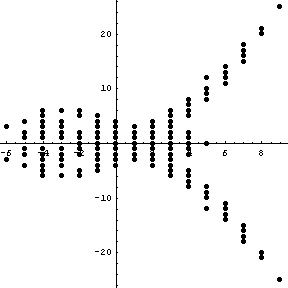Finite Type (Vassiliev) Invariants: Difference between revisions
From Knot Atlas
Jump to navigationJump to search
DrorsRobot (talk | contribs) No edit summary |
DrorsRobot (talk | contribs) No edit summary |
||
| Line 22: | Line 22: | ||
<!--Robot Land, no human edits to "END"--> |
<!--Robot Land, no human edits to "END"--> |
||
{{Graphics1|n=2}} |
{{Graphics1|n=2}} |
||
<pre style="color: red; border: 0px; padding: 0em"><nowiki>ListPlot[ |
|||
Show[ListPlot[ |
|||
Join @@ Table[ |
Join @@ Table[ |
||
K = Knot[10, k] ; v2 = Vassiliev[2][K]; v3 = Vassiliev[3][K]; |
K = Knot[10, k] ; v2 = Vassiliev[2][K]; v3 = Vassiliev[3][K]; |
||
| Line 29: | Line 29: | ||
], |
], |
||
PlotStyle -> PointSize[0.02], PlotRange -> All, AspectRatio -> 1 |
PlotStyle -> PointSize[0.02], PlotRange -> All, AspectRatio -> 1 |
||
]</nowiki></pre> |
|||
]] |
|||
{{Graphics2|n=2|imagename=Finite_Type_Vassiliev_Invariants_Out_2.gif}} |
{{Graphics2|n=2|imagename=Finite_Type_Vassiliev_Invariants_Out_2.gif}} |
||
<!--END--> |
<!--END--> |
||
Revision as of 23:16, 28 August 2005
(For In[1] see Setup)
In[1]:= ?Vassiliev
Vassiliev[2][K] computes the (standardly normalized) type 2 Vassiliev invariant of the knot K, i.e., the coefficient of z^2 in Conway[K][z]. Vassiliev[3][K] computes the (standardly normalized) type 3 Vassiliev invariant of the knot K, i.e., 3J(1)-(1/36)J'(1) where J is the Jones polynomial of K. |
Thus, for example, let us reproduce Willerton's "fish" (arXiv:math.GT/0104061), the result of plotting the values of against the values of , where is the (standardly normalized) type 2 invariant of , is the (standardly normalized) type 3 invariant of , and where runs over a set of knots with equal crossing numbers (10, in the example below):




